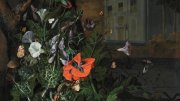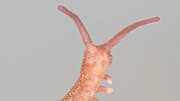Tiny Titans: Dinosaur Eggs and Babies, a new hands-on exhibit at the Springfield Science Museum, brings the prehistoric creatures closer to life. Visitors get to see a variety of fossilized dinosaur eggs and nests collected from across the globe. (That includes a sauropod’s 75-million-year-old bowling-ball-sized egg from Argentina, a cluster of ornithopod eggs laid from China, and, also from China, 18-inch eggs—the longest ever found—from a giant species of oviraptor. These objects offer new perspectives on how dinosaurs reproduced, evolved, and behaved. Lifelike embryos and hatchlings on display highlight nesting and birthing processes, while giant colorful posters contextualize dinosaur habitats. The exhibit also explains how in 1993 American fossil-preparer Charlie Magovern was working on a block of eggs unearthed in China’s Henan Province, when he discovered a nearly complete, fully articulated skeleton of an embryo encased in the stone surrounding the egg—the first of its kind. The embryo was officially identified in 2017 as a new oviraptor species and named Beibeilong sinensis (“baby dragon from China”). This family-friendly exhibit also offers chances to touch replicas of bones and nests, dig for fossils, and learn more about current research into the lives and habits of these ever-fascinating extinct animals. (May 25-September 1)
Springfield Dinosaur Eggs Museum Exhibit
Springfield Dinosaur Eggs Museum Exhibit
A new exhibit featuring fossilized dinosaur eggs and nests from around the world.

Photograph by sILvER PLUME EXHIBITIONS
You might also like
Creepy Crawlies and Sticky Murder Weapons at Harvard
In the shadows of Singapore’s forests, an ancient predator lies in wait—the velvet worm.
Rachel Ruysch’s Lush (Still) Life
Now on display at the Museum of Fine Arts, a Dutch painter’s art proved a treasure trove for scientists.
Concerts and Carols at the Isabella Stewart Gardner Museum
Tuning into one of Boston's best chamber music halls
Explore More From Current Issue

Why America’s Strategy For Reducing Racial Inequality Failed
Harvard professor Christina Cross debunks the myth of the two-parent Black family.

Harvard Economist Wolfram Schlenker Is Tackling Climate Change
How extreme heat affects our land—and our food supply

Rachel Ruysch’s Lush (Still) Life
Now on display at the Museum of Fine Arts, a Dutch painter’s art proved a treasure trove for scientists.




